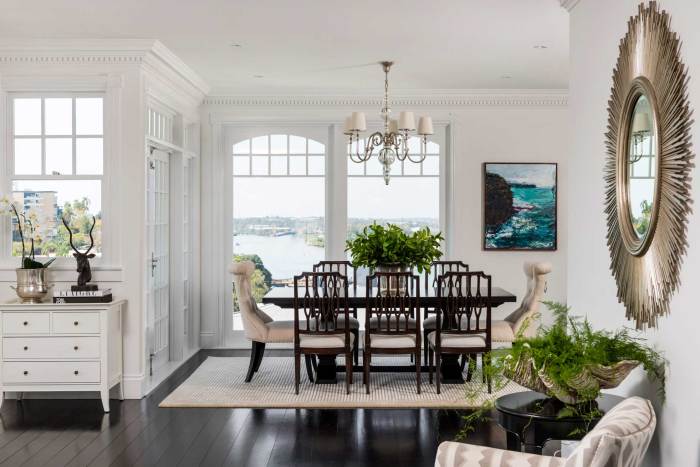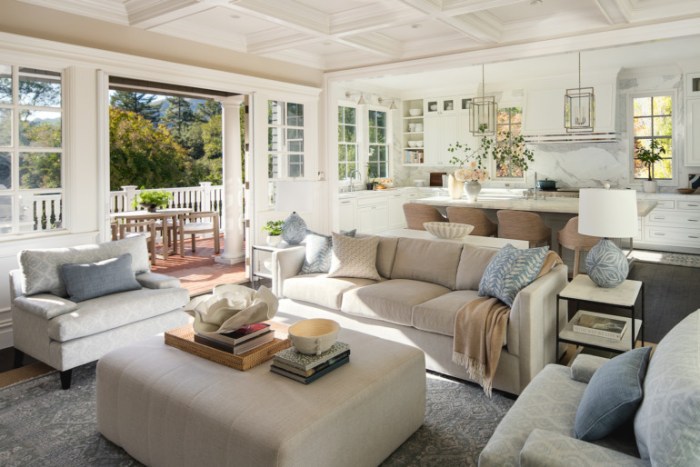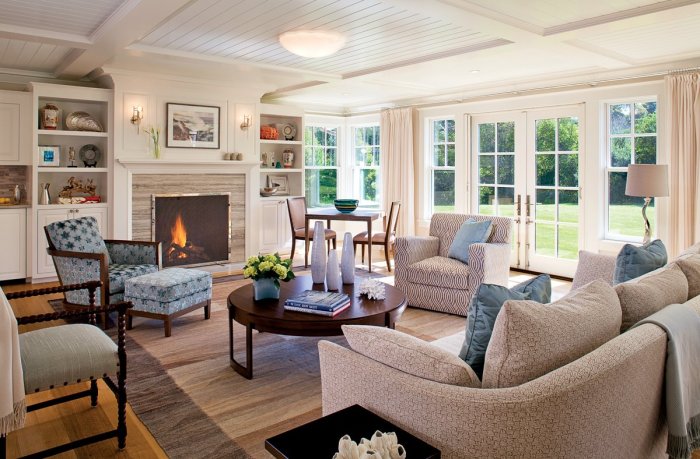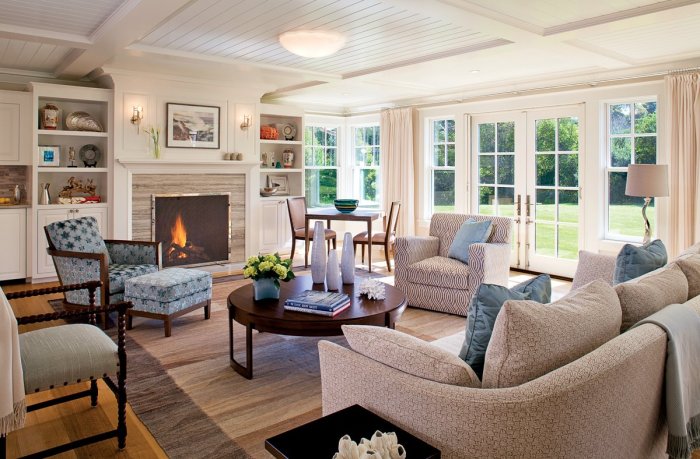Cape house interior design embodies the essence of coastal living, blending functionality with timeless elegance. These charming homes, often steeped in history, offer a unique opportunity to create spaces that are both inviting and reflective of their surroundings.
The signature features of Cape Cod architecture, such as steep roofs, dormers, and symmetrical facades, influence the interior design choices. Simplicity, functionality, and natural light are key principles that harmonize with the Cape Cod aesthetic, creating a welcoming and airy ambiance.
Interior Design Principles for Cape Houses
Cape Cod homes are known for their charming simplicity and timeless elegance. Interior design principles for these homes often reflect the region’s history, coastal lifestyle, and natural beauty. The goal is to create spaces that are both inviting and functional, while honoring the traditional aesthetic.
Color Palettes
Color plays a crucial role in setting the mood and ambiance of a space. Cape Cod interiors often embrace a calming and serene atmosphere, drawing inspiration from the surrounding natural environment.
- Neutral Tones:White, cream, gray, and beige are commonly used as base colors, creating a sense of airiness and light. These colors reflect the natural hues of the beach, sky, and sand, bringing the outdoors in.
- Coastal Accents:Bold pops of color can be introduced through accessories, artwork, and textiles, reflecting the vibrant hues of the ocean. Blues, greens, yellows, and reds, inspired by seashells, ocean waves, and wildflowers, add a touch of whimsy and vibrancy.
- Natural Wood Tones:The warmth of natural wood complements the coastal color palette, adding depth and texture to the space. Reclaimed wood, weathered driftwood, and light-toned oak are popular choices, bringing a sense of rustic charm.
Kitchen Design

The kitchen is the heart of any home, and in a Cape Cod house, it’s no different. This space should be both functional and inviting, reflecting the classic charm and practicality of the Cape Cod aesthetic.
Creating a Functional and Stylish Kitchen Layout
A well-designed Cape Cod kitchen layout should prioritize both functionality and style. A galley kitchen, with its long, narrow design, is a popular choice for Cape Cod homes, as it maximizes space and allows for efficient movement. Consider adding an island to create a central gathering spot, especially if space allows.
Incorporating Cape Cod Elements
To truly capture the essence of Cape Cod, consider incorporating these elements:
- Natural Light:Large windows that flood the kitchen with natural light are essential. Consider using a mix of casement and double-hung windows for a traditional look.
- White Cabinets:White cabinets are a timeless choice for Cape Cod kitchens, creating a clean and airy feel. They also provide a neutral backdrop for colorful accents and accessories.
- Wood Flooring:Hardwood floors, such as oak or pine, add warmth and character to the space. Consider using wide planks for a classic Cape Cod look.
- Exposed Beams:If your kitchen has exposed beams, embrace them! They add a rustic charm that is characteristic of Cape Cod architecture.
Utilizing Materials for a Timeless and Elegant Kitchen
- Wood:Wood is a natural choice for Cape Cod kitchens, adding warmth and texture. Consider using wood for cabinets, countertops, and flooring. Choose species like maple, cherry, or oak for a timeless look.
- Stone:Stone countertops, backsplashes, and floors add a touch of elegance and durability. Granite, marble, and soapstone are all popular choices for Cape Cod kitchens.
- White Cabinetry:White cabinetry creates a sense of space and light, and complements the natural materials often used in Cape Cod kitchens. Consider using shaker-style cabinets for a traditional look.
Incorporating Open Shelving and Farmhouse-Style Sinks
Open shelving adds a touch of rustic charm and allows for display of beautiful dishes and glassware. Choose open shelving in wood or metal to complement the overall design. A farmhouse-style sink, with its deep basin and apron front, adds a touch of country charm.
Consider using a cast iron or stainless steel sink for durability and functionality.
Bathroom Design

The bathroom is a sanctuary in any home, and in a Cape Cod house, it should evoke a sense of relaxation and tranquility. The bathroom design should complement the overall style of the house, incorporating elements that are both functional and aesthetically pleasing.
Creating a Spa-Like Retreat, Cape house interior design
The bathroom should be a space where you can unwind and escape the stresses of daily life. To achieve this, consider using natural materials like stone, wood, and white subway tile. These materials create a calming and inviting atmosphere.
- Natural Stone:Natural stone, such as marble or granite, adds a touch of elegance and sophistication. It is also durable and easy to clean, making it a practical choice for a bathroom.
- Wood:Wood accents, like a vanity or a wooden floor, bring warmth and character to the bathroom. Choose a wood that is resistant to moisture, such as teak or cedar.
- White Subway Tile:White subway tile is a classic choice for bathroom walls. It creates a clean and timeless look that complements a variety of styles.
Incorporating Vintage Fixtures and Nautical Accents
Adding vintage fixtures and nautical accents can enhance the bathroom’s charm and create a unique look.
- Vintage Fixtures:Look for vintage faucets, towel bars, and light fixtures to add character and charm. You can find these at antique shops or online.
- Nautical Accents:Incorporate nautical accents like rope baskets, seashell decor, or a framed nautical chart. These elements will create a coastal vibe and add a touch of whimsy.
Sustainability and Eco-Friendly Design

Cape Cod homes are known for their charming and traditional aesthetics, but embracing sustainable design practices can enhance their appeal while minimizing environmental impact. Incorporating eco-friendly materials, energy-efficient features, and sustainable practices can create a harmonious balance between style and responsibility.
Sustainable Materials
Sustainable materials play a crucial role in creating a green home. These materials are sourced responsibly, minimizing their environmental footprint and promoting long-term durability.
- Reclaimed Wood:Reclaimed wood offers a unique character and reduces the need for new lumber. It’s often sourced from old barns, buildings, or salvaged materials, giving a home a rustic charm and a sense of history.
- Bamboo:Bamboo is a fast-growing and renewable resource that’s incredibly strong and versatile. It can be used for flooring, furniture, and even countertops, adding a natural and sustainable touch to the interior.
- Cork:Cork is a natural and sustainable material derived from the bark of cork oak trees. It’s an excellent choice for flooring and wall coverings, offering insulation, sound absorption, and a unique texture.
- Natural Stone:Locally sourced natural stone, like granite or slate, adds elegance and durability to Cape Cod homes. Using locally sourced materials reduces transportation costs and emissions.
- Recycled Materials:Incorporating recycled materials, such as glass tiles, recycled plastic furniture, or reclaimed metal accents, adds a touch of sustainability and a unique aesthetic to the design.
Energy-Efficient Appliances
Choosing energy-efficient appliances is essential for reducing energy consumption and minimizing environmental impact.
- Energy Star Certified Appliances:Look for Energy Star certified appliances, which meet strict energy efficiency standards set by the U.S. Environmental Protection Agency (EPA). These appliances use less energy, saving money on utility bills and reducing greenhouse gas emissions.
- LED Lighting:LED lights consume significantly less energy than traditional incandescent bulbs and last much longer. Replacing incandescent bulbs with LEDs can significantly reduce energy consumption and contribute to a greener home.
- Smart Thermostats:Smart thermostats learn your heating and cooling preferences and automatically adjust the temperature to optimize energy efficiency. This can significantly reduce energy waste and save money on utility bills.
Natural Lighting
Maximizing natural light is a simple yet effective way to reduce energy consumption and create a bright and inviting interior.
- Large Windows:Large windows allow ample natural light to flood the interior, reducing the need for artificial lighting during the day. Consider using south-facing windows to maximize sunlight exposure.
- Skylights:Skylights can bring in natural light to areas that might not receive sufficient sunlight from windows. They can also create a sense of openness and spaciousness.
- Light Colors:Using light-colored paint and furniture can reflect natural light, making the space feel brighter and more inviting.
Minimizing Waste
Reducing waste is an important aspect of sustainable living.
- Composting:Composting kitchen scraps and yard waste reduces the amount of waste sent to landfills. Compost can be used to enrich the soil in gardens, promoting sustainable gardening practices.
- Recycling:Properly recycling materials like paper, plastic, glass, and aluminum reduces the need for new resources and minimizes landfill waste.
- Reusable Products:Opting for reusable items like cloth bags, water bottles, and food containers reduces the reliance on single-use disposable products.
Ultimate Conclusion
Designing a Cape house interior is a journey of embracing the coastal spirit, incorporating natural elements, and creating a space that reflects the unique charm of these iconic homes. Whether you’re drawn to the rustic warmth of weathered wood or the crisp elegance of white cabinetry, the Cape Cod style offers endless possibilities for crafting a truly personalized and timeless retreat.
Frequently Asked Questions: Cape House Interior Design
What are the most popular color palettes for Cape house interiors?
Popular color palettes often incorporate soft blues, greens, and whites, reflecting the natural hues of the coastal environment. Earthy tones like beige, brown, and gray are also common choices, adding warmth and sophistication.
How can I incorporate traditional elements into my Cape house interior?
Consider incorporating traditional elements like a fireplace, built-in bookshelves, four-poster beds, antique furniture, and nautical accents to enhance the charm and authenticity of your Cape house interior.
What are some tips for creating a sustainable Cape house interior?
Embrace sustainable materials like reclaimed wood, bamboo, and natural fibers. Opt for energy-efficient appliances, maximize natural light, and choose paints and finishes with low VOCs. Consider incorporating green building practices and minimizing waste throughout the design process.
